Taekwondo is a traditional martial art from Korea, known for its “powerful kick” and amazing ability to hit the opponent’s body or head from almost every single position, in a very entertaining way. Taekwondo demonstrations are some of the nicest shows in the world of martial arts, but many kicks can hurt you badly too.
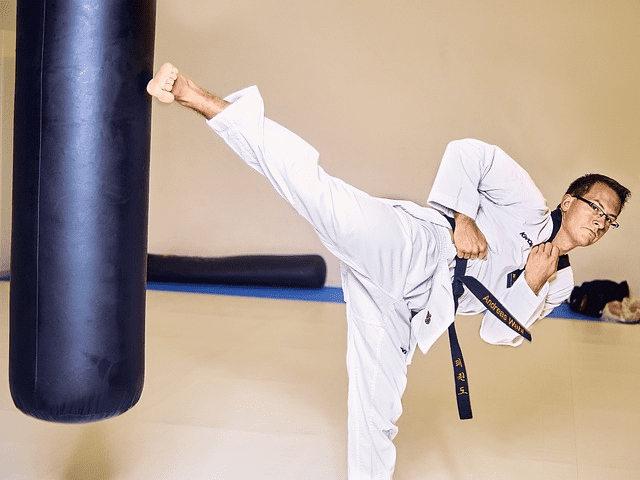
Kicks in Taekwondo are the best in the world of martial arts. This article will focus on the names and detailed descriptions of Taekwondo kicks.
Taekwondo Kicks With Korean Names
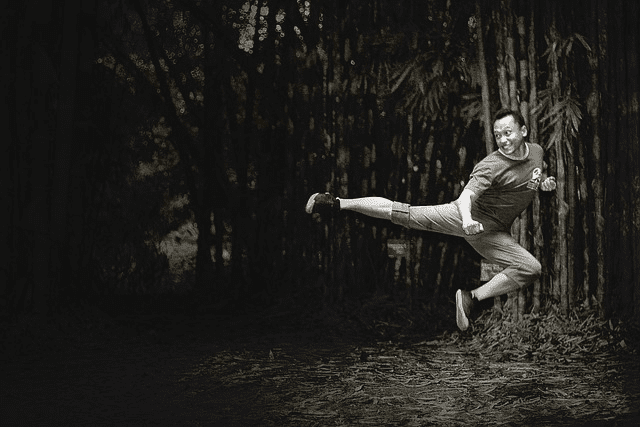
Now it’s time to go through Taekwondo kicks, step-by-step. Every single kick lands on its mark and makes a significant amount of damage if done properly. Taekwondo is way more than a roundhouse strike to solar plexus, it’s a lifestyle and the best kicking style in the world of martial arts for a reason!
The Side Kick (옆 차기, “Yeop Chagi”)

Yeop chagi or side kick targets the opponent’s stomach or head. It is one of the best interceptive techniques when your foe marches forward. But don’t do it with your rear leg in the fight, please, it takes too much time. It is one of the first kicks you’ll learn.
The Roundhouse Kick (돌려 차기, “Dollyo Chagi”)
The roundhouse kick targets the solar plexus, the middle of the stomach, or the opponent’s head. You can see so many variations of a roundhouse kick in Taekwondo competitions, from defensive to offensive ones.
The most dangerous roundhouse kick is the one that lands on the head when the opponent attacks you. If it hits the sweet spot, it leads to a knockout stoppage.
It is also called bandal chagi (to the body) or dollyo chagi (to the head). Lead bandal chagi scores points, while the other one could lead to a KO or a TKO win. The kick dollyo chagi is a very quick variation of a roundhouse kick that might put you to sleep instantly.
Another popular attacking version of the roundhouse kick is the so-called “Brazilian kick” or a modified version of kick dollyo chagi.
It is hard for blocking as it travels around the guard and hits the temple, especially when you do it with a rear leg, which puts it on the list of the most dangerous Taekwondo kicks. You can also see it in Muay Thai or Japanese Karate bouts.
The Back Kick (뒷 차기, “Dwit Chagi”)
This is one of the best ways to counter a kickboxer or a great boxer who leaves himself open when marching forward. Also, if you attack the solar plexus or liver properly, dwi chagi might lead to a fight-ending blow.
Dwi chagi is predominantly a defensive technique when somebody attacks the open side of your fighting stance, but it serves well for the attack too. It can target the head too, but only if you’re flexible enough.
The Reverse Side Kick (반대 옆 차기, “Bandae Yeop Chagi”)
Many call it the sub-variation of a “spinning back kick”, as it is somewhere between a roundhouse kick and a turning kick. There are two differences – the heel hits your opponent, and you don’t switch fighting stance after the strike, you return your kicking leg to the same stanza.
The Inner/Outer Crescent Kick (“An Chagi / Bakkat Chagi”)
Crescent kick is a great clinch strike, especially when the two Taekwondo athletes fight at close range. But don’t try it out in boxing or MMA, you might get floored with a big punch or elbow.
An inside crescent kick, or “an chagi”, is excellent when the fighters are in the same stance. Outer crescent kick works when the two are in the opposite stance. You’ll rarely see a fighter feinting before throwing a crescent kick as it is lightning-fast, not a powerful kick.
Any type of crescent kick will bring three points in a Taekwondo tournament. Masters of the game can combine it with a push kick or a front kick and fake the opponent to fall into a “crescent kick trap” easier. Note: crescent kicks are easy to master point-scoring, not knockout strikes!
The Hook Kick (후려 차기, “Huryeo Chagi”)
Hook kick is the trademark of ITF Taekwondo, and many ITF competitors score tons of points with a leading hook kick (huryeo chagi).
The advanced version is hook kick dollyo chagi, where the fighter intentionally misses with a hook kick and returns the same leg throughout the same path, targeting the foe’s head with a kicking foot.
You can’t expect a knockout with a huryeo chagi in Taekwondo, but a push kick to a hook kick sounds like a great feinting move for scoring points and edging the opponent out in the competition.
Reverse Turning Kick (반대 돌려 차기, “Bandae Dollyeo Chagi”)
The reverse turning kick reminds of a Muay Thai version of a spinning hook kick, as the straight leg travels towards the opponent’s belly or head and you return it to the same stanza. It can make a significant amount of damage, but if you miss, you’re in big trouble. It is one of the trickiest Taekwondo techniques and back kicks.
On the other hand, there is another version of bandae dollyo chagi, which is a bit more of a snap kick. There you go, check this video out.
The Axe Kick (내려 차기, “Naeryeo Chagi”)
Axe kick is a very tricky strike for kickboxers or other martial arts experts, as it cracks through double pillars with ease.
An axe kick can hurt the opponent badly if he tries to duck under, but moving his head to the side works well for the defense. Naeryeo chagi can break the clavicle bone in some cases too. Check out the K-1 fight between Park Yong Soo and Kaoklai Kaennorsing for more details.
The Knee Strike (“Mureup Chigi”)
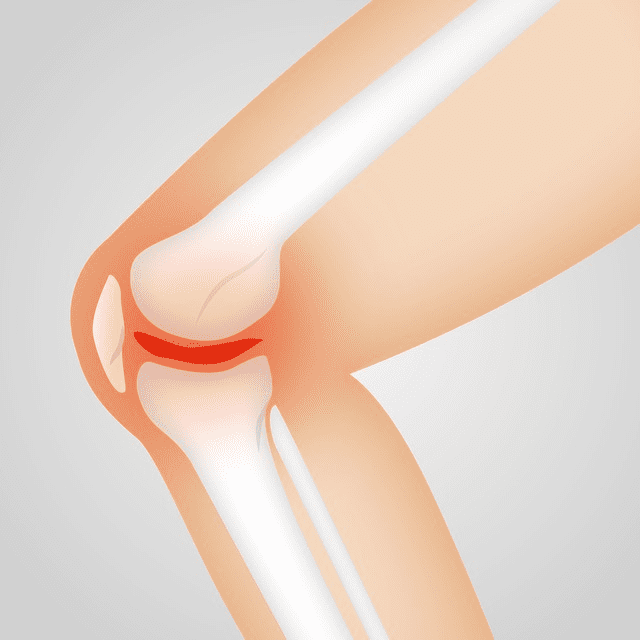
Taekwondo knee strike works for self defense, but it is illegal in sports competitions. Do it and you’ll get a warning or a point abduction.
A knee strike might not hurt the opponent too much but it will work if you hit the solar plexus or family jewels. Many like to call it “a dirty strike”.
The Scissor Kick (“Kawi Chagi”)
Scissor kick is a demonstrational technique, but better don’t try it out in combat. You’ll waste a lot of energy, and if you miss your kawi chagi, the foe might land a big counter to your head and knock you out.
It kinda reminds me of a Showtime kick in MMA, the chance of hitting your opponent is very small, plus it’s not a powerful kick.
The Flying Side Kick & Flying Back Kick (“Twi Myo Yeop Chagi / Twi Myo Dwi Chagi”)
If you’re a diehard fan of MMA, Fabricio Werdum does flying side kick nicely. It is hard to hit the enemy with a twi myo yeop chagi, but a foot to the chin could lead to a violent KO.
On the other hand, twi myo dwi chagi, or a flying back kick, is a brutal way to counter an aggressive opponent. You can break his ribs or cause internal bleeding with this strike. It is also a nice attack off the clinch. It is one of the most brutal jump kicks.
For example, you can intentionally miss with a front kick and punish your opponent with this type of strike.
Why Taekwondo Is Heavy On Kicking?

Taekwondo is not all about kicking leg and leg strikes, as the students learn how to use their hands in self defense. Yet, instructors believe that legs are longer and more powerful weapons compared to arms, so the emphasis is on leg training.
Plus, for example, front kick ap chagi is a very powerful kick that is easy to master, alongside Taekwondo versions of push kick and front kick, and all these strikes could save you from the attacker in the street.
Why Does Taekwondo Not Have Low kicks?
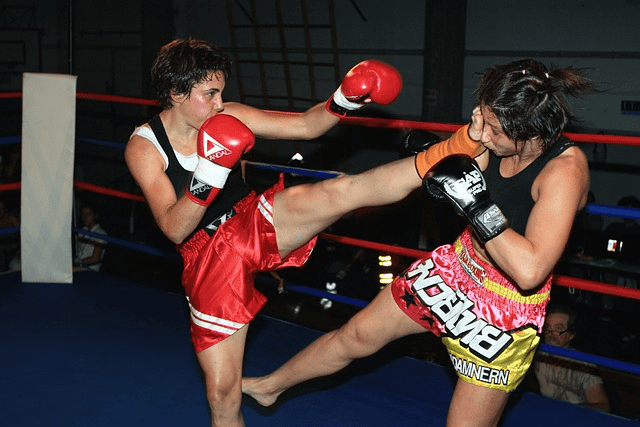
Taekwondo rules prohibit kicking the opponent under the belt. You will get a kyong-go (warning) when you hit below the hip in the tournament. Plus, the risk of permanently disabling injury is too high, especially when you hit a calf or a knee with a round house kick.
How Can I Learn All Taekwondo Kicks Perfectly?
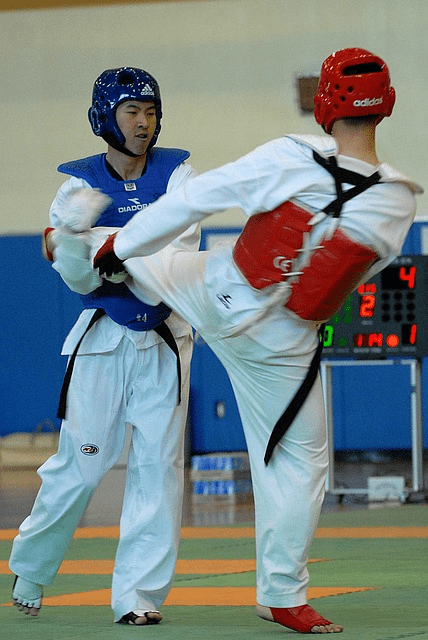
Practice makes perfect certainly applies here. You need years of training, good flexibility, and persistence to master all Taekwondo kicks. It is one of the most difficult martial arts in the world.
For example, you can learn ap chagi in two weeks, but tornado kick and other spinning kicks demand at least 5,000-10,000 repetitions to master. Do the same kick over and over and don’t give up, that is the best piece of advice you can get!
Remember, as much as your determination to repeat a specific kick contributes to mastering it, ensuring you have the best Taekwondo shoes on can be a game-changer, allowing for better support and hygiene during long, draining training sessions.”
A good Taekwondo practitioner is one that never stops training!
Steps
Carrying Out A Side Kick
Yeop chagi is pretty much a difficult strike as you need a decent amount of flexibility, especially if you plan to land on the head. First, learn ap chagi, then master the phases of a side kick. This tutorial could come in handy. Use the wall to your advantage.
Completing The Hooking Kick
You’ll need solid flexibility again, so make sure that you can raise the leg at least to the level of your head. Learn roundhouse kicks first, as this is completely the opposite move. This tutorial could come in handy, hook Taekwondo kicks are a very powerful weapon.
Note: you must learn hook kicks properly to master a spinning hook kick! Do not skip steps or you’ll never be able to turn the lights out on your opponent with this strike!
Executing The Back Kick
You’ll have to use the wall to your advantage. First, grab the wall and learn all four phases of this strike. Raise your knee, extend your leg backward, return it to your knee, and put it down. Of course, you must master the front kick and roundhouse kick to be able to think about the back kick.
Turn your back towards the opponent, perform the kick, and put your leg down ahead of yourself, switching the stance from southpaw to orthodox or vice versa.
How Do You Do A Traditional Back Kick?
When you turn your back, you should return your leg straight to the same stance, via the same path.
How Do You Do A Spinning Back Kick?
After you turn your back and deliver a strike, change the stance to southpaw and don’t return the leg – that is the difference between this and the traditional version. By the way, this one is more efficient for self defense.
How Do You Do A Spinning Hook Kick?
You must master hook kick and dwit chaggi to be able to perform this strike. Do you know this? Great, then turn your back towards your opponent and hit his head through a hooking motion, it’s going to be a piece of cake for you! It is one of the most dangerous techniques in the martial arts world!
How Do You Do A Jumping Back Kick?
Make sure you are not far away from your opponent. The movement is the same as a spinning back kick, but you must switch your legs whilst in the air and move at least a bit backward because it creates a distance between you and your target. It is one of the most complicated martial arts techniques though.
Is Kicking A Good Workout?
Yes, kicking wastes a lot of energy. Kicks waste more cardio than punches, which means you’ll burn more calories compared to boxing or kickboxing.
When Should You Use A Back Kick?
Back kicks can work in three situations:
- When the opponent rushes towards you, that’s a great way of interception, especially for self defense.
- When an orthodox meets an orthodox (and vice versa), there is a lot of space for spin kicks.
- If you’re down on the scorecards and you’re trying to knock your opponent out or score four points via a spinning technique like a tornado kick or a dwi huryeo chagi.
Is It Dangerous to Hit A Person With A Back Kick?
Of course, Taekwondo practitioners can knock a person out cold or break the bully’s ribs or damage internal organs with a violent back kick. If they master advanced kicks, the situation gets worse and worse for the attacker too.
Achieving The Perfect Roundhouse Kick
Learn ap chagi and bandal chagi properly, then we can talk about a perfect roundhouse kick. Make sure that your leg ends up in front of your standing leg, so upon the finish, switch your stance from orthodox to southpaw or vice versa. Your back leg becomes your leading leg!
Hand Attacks

In modern Taekwondo, punches play an important role, as judges score jireugis (hand strikes) pretty often.
Punches Are A Secret Weapon
A good punch to the body can stop the opponent and lead to a knockdown. Also, a hook to the body is legal, and it can counter bandal chagi to the body, especially with your lead arm.
How To Throw A Punch In Taekwondo
This tutorial will help you – one hand protects your body from the attack, while the other one targets the opponent’s plexus or the spot under the sternum.
Types Of Punches Thrown In Taekwondo
There are many types of Jireugis (punches), but the majority of them are thrown as counters when the opponent attacks you to the body. You can also make a step forward and aim with a punch to the body (1 point), or try to continue the attack after a roundhouse kick with a jireugi to prevent yourself from counters.
Lead hook to the body works too, but judges will rarely score this in the competition. Yet, it could stop the attacker efficiently, it works for self defense.
Technically, uppercut and spinning back fists exist in forms (similar to Kata in Karate), but you can’t do it in a fight. I mean, you can technically, Hwoarang does it in a Tekken video game, but rules prohibit punching to the head, and spinning back fist to the body is very weak.
Moves
The list of Taekwondo moves includes kicks, five stances, blocks (seven basic ones), punches, and forms.
What Is Taekwondo Most Iconic Move?
The most iconic move is a jumping spinning hook kick to the head, but this list also includes a tornado kick to the head, or, for example, a 720-degree spinning hook kick. Reverse tornado kick is another dark horse among kicking techniques too.
Blocks
Here is the list of basic Taekwondo blocks. All of them serve to defend, but they save from different strikes.
Knife Hand Block
This is meant to carry, grab, catch or deflect; put your guard up, hands open, and keep your fingers pressed together to protect your face.
Closed Hand Block
Close your hands into fists to block your head. This block, similar to double pillars, works well against a jumping front kick and all kinds of straight leg strikes or jabs/crosses.
Outer Forearm Block – Bakat Palmok Makgi
Your front arm snaps into a horizontal frame and blocks the attacker’s limb in front of you.
Low Block – Arae Makgi
Your outside arm protects the body from lower leg strikes and other kicks to the liver, spleen, or internal organs.
High Block – Ulgool Makgi
It prevents all kicks taught to the head. Press one arm to the side, and extend the other one upward, palm facing out.
Inner Forearm Block – An Makgi
Step forward and make a chopping motion extending the arm vertically. The inside of the arm absorbs the shock and works well against ap chagi, a front kick, or a jumping front kick.
Rising Block – Chookya Makgi
Protects head and shoulders, inner arm absorbs the attack from above. Raise your arm horizontally to cover your head.

